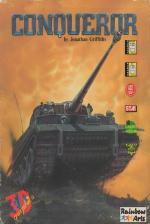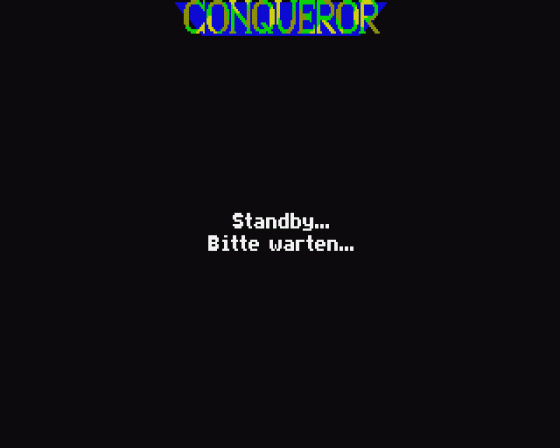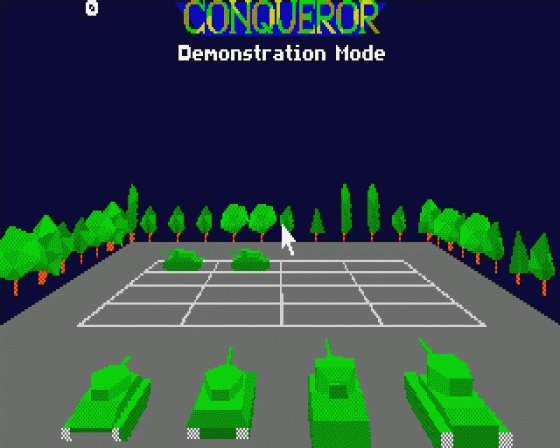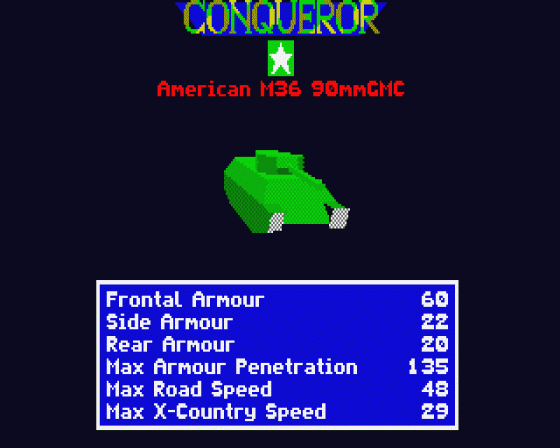
ST Format
 1st May 1990
1st May 1990
Categories: Review: Software
Author: Mark Higham
Publisher: Rainbow Arts
Machine: Atari ST
Published in ST Format #9
Conqueror
Hyper-realism - slavish attention to detail at the expense of gameplay - has killed many a promising simulation stone dead. Now comes Conqueror, a tank sim unlike any other, making little concession to the limitations of harsh reality and with the emphasis instead on hair-raising action and speed...
Somewhere in between Grand Monster Slam and Revenge Of The Mummy, Rainbow Arts just lost it. For a while back there, they came perilously close to tumbling into that twilight zone of homebrew software houses churning out half a game once a year. Setting eyes on Conqueror for the first time is a real slap in the face if you were expecting that trend to continue.
Old finger-on-the-pulse games hacks, who would admit to remembering back as far as the days of Virus and Elite will see something familiar in the Conqueror screens. They bear a noticeable resemblance to the unique graphic environment invented by David Braben in the classic space-trading game Elite. Braben was brought into the Conqueror project to write the movement and landscape routines and much of the game's appeal can be attributed to his unusual playing area.
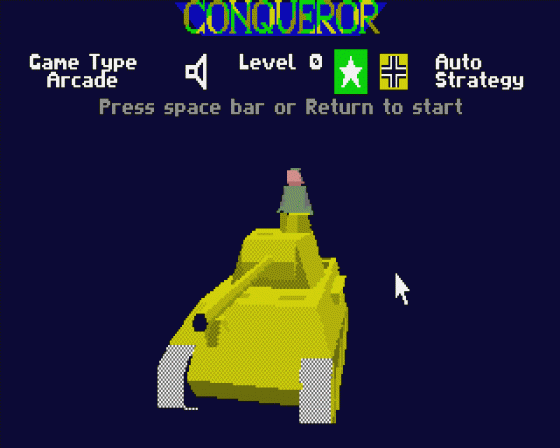
Conqueror doesn't try to be a straight tank simulation, concentrating instead on addictive gameplay. Three modes of play combine action with strategy, enabling you to adjust the game as your playing skills develop.
In the action game, the easiest of the three, you control just one tank and use it to blast others on the map. As you smash more and more enemy tanks, your own tank develops into a Herculean monster. Unfortunately the enemy is also growing in strength. It's not possible to track other tanks because of the size of the battlefield, so call up a map which displays the location of enemy tanks.
Attrition mode is an alliance of action and strategy. You're decked out with a standard selection of tanks consisting of one light, two medium and two heavy-duty machines. The computer begins the game with an inferior selection but these steadily increase until they outnumber your own. You can only control one tank at a time, but you can program other tanks from the map to head straight for certain locations. Should the programmed tanks encounter an enemy presence, they'll go into battle mode and fight until one ends up as scrap metal.
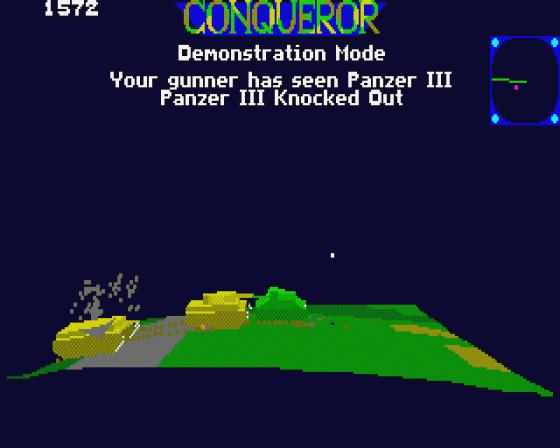
Strategy mode is the top level and the objective is to hold an area of ground for one minute. Victory depends on spending a considerably amount of time studying the map where the area of ground you're defending is represented by a large circle. You must move your tank into the designated area and then keep all enemy tanks out of it. As in the attrition mode, you have other tanks which can be programmed to move to various locations on the map. If your situation looks irredeemable, you also have the opportunity to fire on the map - providing you've amassed enough points.
In other games, points are little more than an ego-boost but in the attrition and strategy modes they serve an important purpose. In these modes you cannot see enemy tanks on the map, but with enough points at your disposal you can dispatch a spotter plane to relay details of the enemy's location. Points also give you the opportunity to buy more tanks from a selection of light to heavy-duty machines and allow you to build up teams to patrol the map.
Effects
The unique Braben environment sets Conqueror apart from other games. If you're not familiar with it already, be prepared for some serious entertainment. The ground looks like a rolling sheet with bullets and track marks represented by small squares. Sprites such as tanks, trees and houses are shown as solid 3D objects. The resulting presentation gives the game its own unique Braben-style.
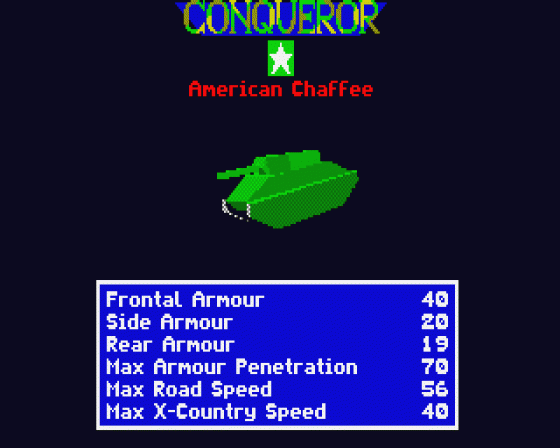
Explosions and fire noises make up the bulk of the sound effects. They aren't particularly boisterous and don't occur in any great profusion, but effectively reinforce the atmosphere of combat.
Groovy Moves
The contours of the map are displayed as different shades of colour; the darker the shade, the higher the land. Landmarks such as villages, woods and rivers are shown and, although you can crash straight through these, they slow you down to such a degree that you'd be advised to find an alternative route. Travelling along roads sends your tank speeding to its destination, so it's well worth sticking to tarmac.
The tank under your direct control is represented as a cyan dot on the map; your other tanks appear as yellow dots. A similarly coloured X can be positioned on the map by you and denotes where the selected tank is being sent. Any tanks not directly under your control are moved by the computer. If selected to CHARGE, they head straight for the indicated destination ignoring alternative routes.
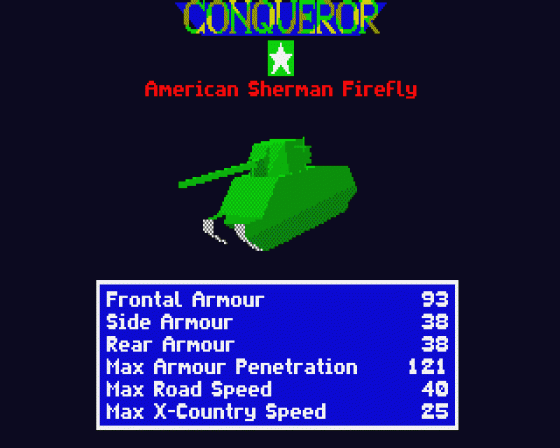
Since the action freezes while you stare at the map, you're given plenty of time to cultivate sophisticated attack plans. This is particularly important in the strategy mode where planning dictates whether or not you win the game. In this mode, you can't see the location of other tanks. For 500 points, however, you can dispatch a spotter plane over the area and the enemy tanks are displayed. When you return to the map these tanks are removed and you need to send a new plane to reconnoitre for up to date information.
In strategy mode you can call artillery stationed off the battlefield to fire on the map. This bombardment costs a valuable 1500 points and causes between 16 and 31 shells to land near the selected spot. With sledgehammer features like this, who needs a nuke button?
Verdict
Outstanding games don't often just come out of the blue but that's how Conqueror made its dramatic entrance. If a game can succeed without receiving masses of hype and six months advance release publicity, you know it's got to be something special - and Conqueror certainly falls into that category.
With everyone else struggling to make games more and more realistic and super-fast, finding something both unremittingly addictive and graphically original is rare. Conqueror has both these qualities in abundance and deserves immense success because of them.

